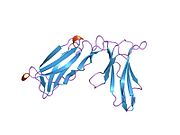KIR2DS4
KIR2DS4| KIR2DS4 | |||||||||||||||||||||||||
|---|---|---|---|---|---|---|---|---|---|---|---|---|---|---|---|---|---|---|---|---|---|---|---|---|---|
 | |||||||||||||||||||||||||
| |||||||||||||||||||||||||
| 식별자 | |||||||||||||||||||||||||
| 별칭 | KIR2DS4, CD158I, KIR1D, KIR2DS1, KIR412, KKA3, NKAT-8, NKAT8, KIR-2DS4, 수용체 같은 킬러 세포 면역글로불린, Ig 도메인 2개와 짧은 세포질 꼬리 4 | ||||||||||||||||||||||||
| 외부 ID | OMIM: 60495 GeneCard: KIR2DS4 | ||||||||||||||||||||||||
| |||||||||||||||||||||||||
| |||||||||||||||||||||||||
| |||||||||||||||||||||||||
| 직교체 | |||||||||||||||||||||||||
| 종 | 인간 | 마우스 | |||||||||||||||||||||||
| 엔트레스 |
| ||||||||||||||||||||||||
| 앙상블 |
| ||||||||||||||||||||||||
| 유니프로트 |
| ||||||||||||||||||||||||
| RefSeq(mRNA) |
| ||||||||||||||||||||||||
| RefSeq(단백질) |
| ||||||||||||||||||||||||
| 위치(UCSC) | Cr 19: 54.83 – 54.85Mb | n/a | |||||||||||||||||||||||
| PubMed 검색 | [2] | n/a | |||||||||||||||||||||||
| 위키다타 | |||||||||||||||||||||||||
| |||||||||||||||||||||||||
킬러 세포 면역글로불린 유사 수용체 2DS4는 인간 내 KIR2DS4 유전자에 의해 암호화된 단백질이다.[3][4][5]
킬러 세포 면역글로불린 유사 수용체(KIRs)는 자연 킬러 세포와 T 세포의 서브셋에 의해 발현되는 트랜섬브레인 당단백질이다.KIR 유전자는 다형성 및 고동맥성으로 1Mb 백혈구 수용체 복합체(LRC) 내 염색체 19q13.4의 성단에서 발견된다.여러 "프레임워크" 유전자가 모든 하플라타입(KIR3DL3, KIR3DP1, KIR3DL4, KIR3DL2)에서 발견되기는 하지만 KIR 유전자 군집의 유전자 함량은 하플라타입에 따라 다르다.KIR 단백질은 세포외 면역글로불린 영역 수(2D 또는 3D)와 세포질 영역이 긴지 짧은지(S)로 분류된다.면역 티로신 기반 억제 모티브(ITIM)를 통해 리간드 결합 시 긴 세포질 영역 변환 억제 신호를 가진 KIR 단백질은 ITIM 모티브가 부족한 반면, 짧은 세포질 영역을 가진 KIR 단백질은 대신 TYRO 단백질 티로신 키나제 결합 단백질과 결합하여 변환 활성 신호를 만든다.몇몇 KIR 단백질의 리간드는 HLA 등급 I 분자의 하위 집합이므로, KIR 단백질은 면역 반응의 조절에 중요한 역할을 한다고 생각된다.[5]
참고 항목
참조
- ^ a b c ENSG00000274406, ENSG00000277078, ENSG00000274807, ENSG00000275353, ENSG00000275731, ENSG00000273526, ENSG00000275351, ENSG00000274921, ENSG00000277345, ENSG00000276885, ENSG00000284408, ENSG00000274957, ENSG00000276154, ENSG00000284307, ENSG00000283779, ENSG00000274324, ENSG00000221957, ENSG00000274714, ENSG00000274533, ENSG00000276209, ENSG00000276634, ENSG00000276465, ENSG00000274947, ENSG00000283727, ENSG00000283846, ENSG00000276395, ENSG00000275938, ENSG00000284244, ENSG00000284264, ENSG00000283870, ENSG00000283882, ENSG00000276254 GRCh38: Ensembl release 89: ENSG00000273931, ENSG00000274406, ENSG00000277078, ENSG00000274807, ENSG00000275353, ENSG00000275731, ENSG00000273526, ENSG00000275351, ENSG00000274921, ENSG00000277345, ENSG00000276885, ENSG00000284408, ENSG00000274957, ENSG00000276154, ENSG00000284307, ENSG00000283779, ENSG00000274324, ENSG00000221957, ENSG00000274714, ENSG00000274533, ENSG00000276209, ENSG00000276634, ENSG00000276465, ENSG00000274947, ENSG00000283727, ENSG00000283846, ENSG00000276395, ENSG00000275938, ENSG00000284244, ENSG00000284264, ENSG00000283870, ENSG00000283882, ENSG00000276254 - 앙상블, 2017년 5월
- ^ "Human PubMed Reference:". National Center for Biotechnology Information, U.S. National Library of Medicine.
- ^ Bottino C, Sivori S, Vitale M, Cantoni C, Falco M, Pende D, Morelli L, Augugliaro R, Semenzato G, Biassoni R, Moretta L, Moretta A (Oct 1996). "A novel surface molecule homologous to the p58/p50 family of receptors is selectively expressed on a subset of human natural killer cells and induces both triggering of cell functions and proliferation". Eur J Immunol. 26 (8): 1816–24. doi:10.1002/eji.1830260823. PMID 8765026. S2CID 23526107.
- ^ Wagtmann N, Biassoni R, Cantoni C, Verdiani S, Malnati MS, Vitale M, Bottino C, Moretta L, Moretta A, Long EO (Jun 1995). "Molecular clones of the p58 NK cell receptor reveal immunoglobulin-related molecules with diversity in both the extra- and intracellular domains". Immunity. 2 (5): 439–49. doi:10.1016/1074-7613(95)90025-X. PMID 7749980.
- ^ a b "Entrez Gene: KIR2DS4 killer cell immunoglobulin-like receptor, two domains, short cytoplasmic tail, 4".
추가 읽기
- Döhring C, Samaridis J, Colonna M (1996). "Alternatively spliced forms of human killer inhibitory receptors". Immunogenetics. 44 (3): 227–30. doi:10.1007/BF02602590. PMID 8662091. S2CID 38478576.
- Kim J, Chwae YJ, Kim MY, et al. (1997). "Molecular basis of HLA-C recognition by p58 natural killer cell inhibitory receptors". J. Immunol. 159 (8): 3875–82. PMID 9378975.
- Campbell KS, Cella M, Carretero M, et al. (1998). "Signaling through human killer cell activating receptors triggers tyrosine phosphorylation of an associated protein complex". Eur. J. Immunol. 28 (2): 599–609. doi:10.1002/(SICI)1521-4141(199802)28:02<599::AID-IMMU599>3.0.CO;2-F. PMID 9521070.
- Chwae YJ, Cho SE, Kim SJ, Kim J (1999). "Diversity of the repertoire of p58 killer cell inhibitory receptors in a single individual". Immunol. Lett. 68 (2–3): 267–74. doi:10.1016/S0165-2478(99)00062-0. PMID 10424431.
- Fan QR, Long EO, Wiley DC (2000). "Cobalt-mediated dimerization of the human natural killer cell inhibitory receptor". J. Biol. Chem. 275 (31): 23700–6. doi:10.1074/jbc.M003318200. PMID 10816589.
- Rajalingam R, Gardiner CM, Canavez F, et al. (2001). "Identification of seventeen novel KIR variants: fourteen of them from two non-Caucasian donors". Tissue Antigens. 57 (1): 22–31. doi:10.1034/j.1399-0039.2001.057001022.x. PMID 11169255.
- Katz G, Markel G, Mizrahi S, et al. (2001). "Recognition of HLA-Cw4 but not HLA-Cw6 by the NK cell receptor killer cell Ig-like receptor two-domain short tail number 4". J. Immunol. 166 (12): 7260–7. doi:10.4049/jimmunol.166.12.7260. PMID 11390475.
- Hsu KC, Liu XR, Selvakumar A, et al. (2002). "Killer Ig-like receptor haplotype analysis by gene content: evidence for genomic diversity with a minimum of six basic framework haplotypes, each with multiple subsets". J. Immunol. 169 (9): 5118–29. doi:10.4049/jimmunol.169.9.5118. PMID 12391228.
- Maxwell LD, Wallace A, Middleton D, Curran MD (2003). "A common KIR2DS4 deletion variant in the human that predicts a soluble KIR molecule analogous to the KIR1D molecule observed in the rhesus monkey". Tissue Antigens. 60 (3): 254–8. doi:10.1034/j.1399-0039.2002.600307.x. PMID 12445308.
- Strausberg RL, Feingold EA, Grouse LH, et al. (2003). "Generation and initial analysis of more than 15,000 full-length human and mouse cDNA sequences". Proc. Natl. Acad. Sci. U.S.A. 99 (26): 16899–903. doi:10.1073/pnas.242603899. PMC 139241. PMID 12477932.
- Artavanis-Tsakonas K, Eleme K, McQueen KL, et al. (2004). "Activation of a subset of human NK cells upon contact with Plasmodium falciparum-infected erythrocytes". J. Immunol. 171 (10): 5396–405. doi:10.4049/jimmunol.171.10.5396. PMID 14607943.
- Maxwell LD, Williams F, Gilmore P, et al. (2005). "Investigation of killer cell immunoglobulin-like receptor gene diversity: II. KIR2DS4". Hum. Immunol. 65 (6): 613–21. doi:10.1016/j.humimm.2004.02.028. PMID 15219381.
- Katz G, Gazit R, Arnon TI, et al. (2004). "MHC class I-independent recognition of NK-activating receptor KIR2DS4". J. Immunol. 173 (3): 1819–25. doi:10.4049/jimmunol.173.3.1819. PMID 15265913.
- Yen JH, Lin CH, Tsai WC, et al. (2006). "Killer cell immunoglobulin-like receptor gene's repertoire in rheumatoid arthritis". Scand. J. Rheumatol. 35 (2): 124–7. doi:10.1080/03009740500381252. PMID 16641046. S2CID 29445959.
이 기사는 공공영역에 있는 미국 국립 의학 도서관의 텍스트를 통합하고 있다.











